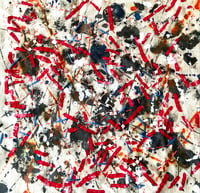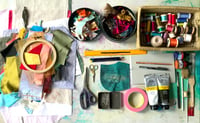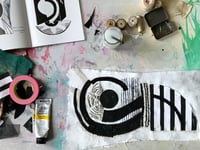Painting with Textiles ONLINE COURSE
Lesson release dates: 15 - 26 July 2024
Continued access period: LIFETIME.
SYLLABUS: In this course you will explore a range of fabrics and stitch techniques that will allow you to use textiles as if they were paint. Thread will become ink and graphite, and soft matte fabrics drenched in colour will play the part of gouache. Stained gossamer layers will replace watercolour and loose ink washes. Couched fragments will be daubs of rich oil, while reverse applique will allow you to scrape away at your paintings. French knots will provide stippling, and seed stitches will allow you to express yourself through pointilism.
Simple collage methods and slow hand stitching, using a wooden hoop, will be the main methods of construction and mark making in this course. Ink and paint will also be used to alter and customise fabric before (and sometimes after) stitching.
For some, this course will be as much about enjoying and understanding the work of great painters, such as Matisse, Delauney, Rothko, and Frankenthaler, through the prism of textiles.
You might be a painter who has never stitched, or a quilter who has never painted. You may have held neither brush nor needle in your life…this course is suitable for all.
FORMAT: a new session (ten in total) will be uploaded to a course page on my website every weekday at around 9am UK time (GMT or BST, depending on month) during the dates you select. Each daily session will include a learning objective, topic overview, contextual description, and video tutorial. In addition, two short bonus films, with briefs for weekend activities, will be shared on the two Friday afternoons. Once content is activated, it will remain accessible to you for the lifetime of the course. When I eventually decide to retire the course, I will email and give you four months notice of its removal. You therefore get the pace and rhythm of a real-time course, with the benefit of recorded content being replayable repeatedly anytime regardless of time zone or schedule.
ACCESS: I will email a link and password for the course page on the Friday before your course commences. Please be sure to type your email address correctly, so your access email doesn't go astray. If you haven't received your access link and password 48 hours before the course commences, please check your junk folder and/or email me at [email protected].
PRICING: The concessionary price is offered on an honesty-box basis. If your income is low, for whatever reason, please select concession. No explanation necessary.
MATERIALS:
- Fabric (see *below)
- Thread (see *below)
- Embroidery hoop (any size from 10cm/4” to 25cm/10” will be fine)
- Scissors (ideally, one pair for cutting fabric, and a small pair for cutting thread)
- Ruler
- Colouring pencils (one light, one dark)
- Masking tape
- Pins
- Needles (in a range of sizes – standard and embroidery)
- Acrylic ink – two bottles (any colour), the sort with droppers set in their lids
- Acrylic paint (black and white)
- Artist’s paint brush (medium size, all purpose, round, synthetic bristles)
- Items for mark making (such as a knitting needle, drinking straw, toothbrush, lolly stick, lego block etc)
- Newspaper
- Notebook and pen
*A note regarding fabric and thread:
This course is focused on method and process, with inventiveness and developing your own approach at its heart. I’m therefore not being too prescriptive about textile materials. You certainly will need to have a nice selection of textiles to work with…I’m just letting you select and assemble the palette for yourself.
There are a few “essentials”, however. You will need to have at least twelve pieces of plain (not patterned) non-stretchy linen or cotton material. These need to be at least as big as your embroidery hoop. They will provide the base for every lesson and each weekend project. It would be nice if there was some variety in these twelve pieces. They can be any colour, texture, or weight (as long as you can comfortably push a needle through). You might have a scrap bag with plenty of choice, or you may need to look online for a bundle of remnants or offcuts or visit a charity shop and buy items like tea towels, handkerchiefs, napkins, and clothing. You will also need a selection of fabric scraps. These can be any size or shape (tiny fragments are often the jewels in a piece). The more variety the better. Here’s a random list of the kinds of fabrics you might find scraps of useful: knitted jersey, shiny satin, floaty silk, boucle, net, lace, organza, tulle, denim, damask, ticking, chambray, seersucker, corduroy, fleece…. To be clear, it absolutely isn’t my intention that you should go and buy yardage of these new from a haberdasher…just a few scraps will go a long way. Again, you might need to look online if you don’t have a bag of scraps already. Sari silk offcuts, throwster’s waste, dyed fleece…these are all sold online in delicious bundles. Think out of the box too. Ribbons from gifts, rice bags, dish cloths, net bags from fruit…these would all be great. As far as thread goes, you will need some reels of standard sewing thread and skeins of stranded embroidery cotton. Both of these, in a range of colours. Also, think of other thread-like materials that will fit through the eye of a large needle. Garden twine, darning thread, knitting yarn, quilting thread, linen cord, natural cordage….
What you want to do is amass a palette of bit and bobs that you will be able to think of as if they are colouring pencils, paint, and collage papers.
COPYRIGHT: all content is my own. Bookings are for single or household use only. Please do not reproduce or share any course product - passwords, text, images, downloadable content, videos - without my written permission.




